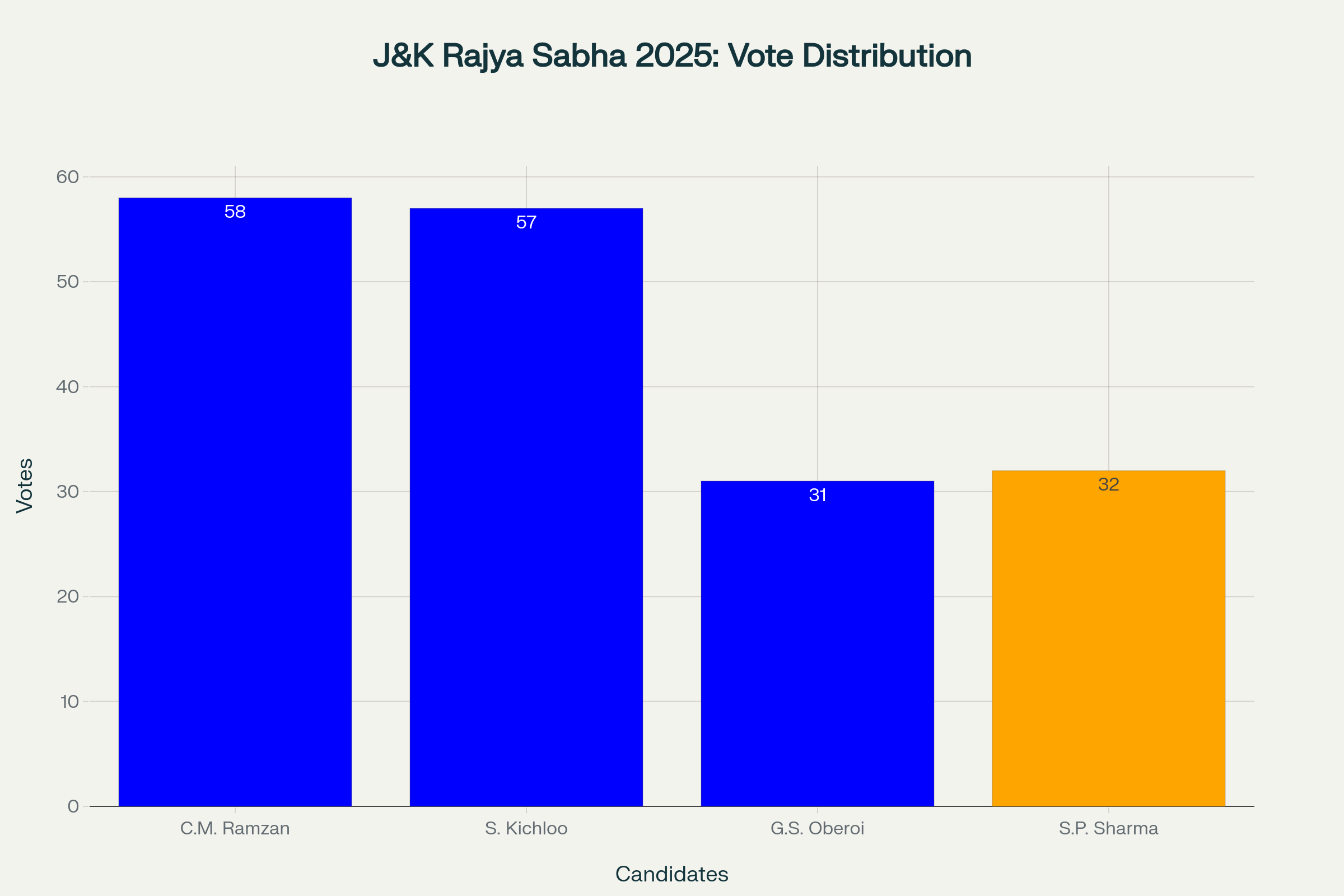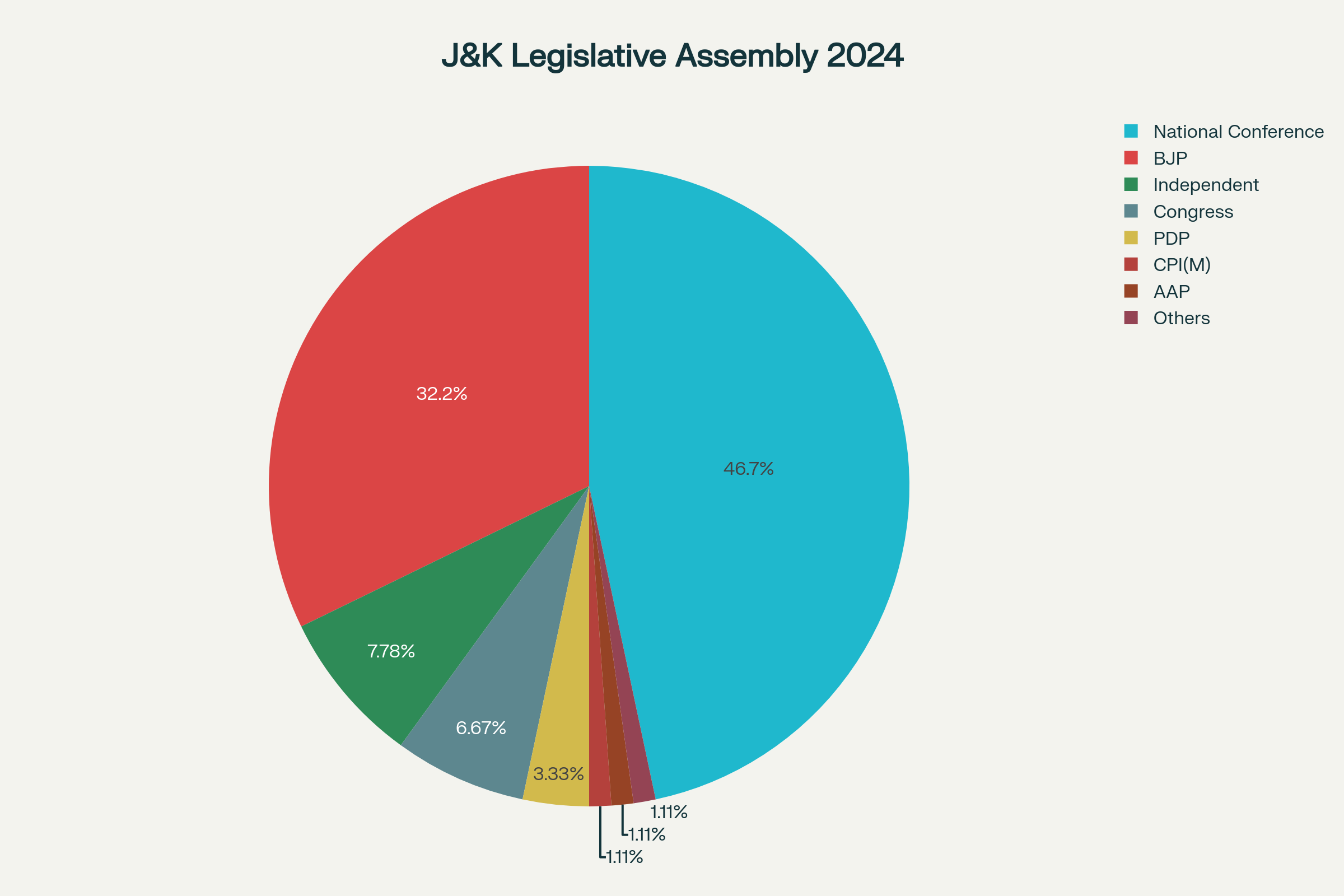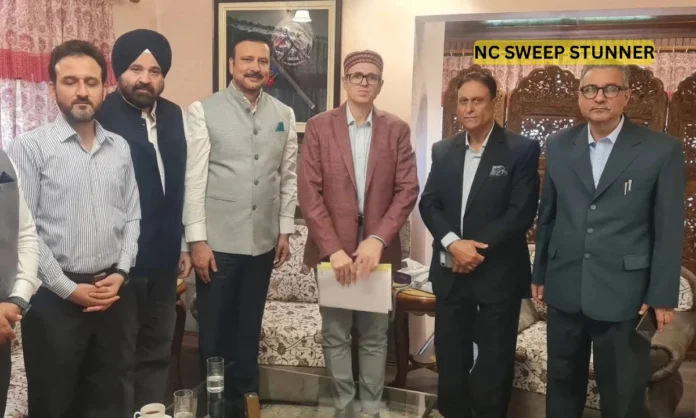Key Highlights:
- National Conference dominates with three victories in first Rajya Sabha polls since Article 370 abrogation
- BJP’s shocking win with 32 votes despite having only 28 MLAs exposes cross-voting controversy
- Historic elections end four-year Upper House representation vacuum in Jammu and Kashmir
Opening Overview
The J and K Rajya Sabha Election Shocker delivered stunning results as the National Conference secured three seats while the BJP achieved an unexpected victory through suspected cross-voting in the Union Territory’s first Upper House polls since 2019. This J and K Rajya Sabha Election Shocker unfolded on October 24, 2025, when Omar Abdullah’s National Conference won three of four contested seats, but the BJP’s Sat Paul Sharma defied electoral arithmetic by securing 32 votes despite the party having only 28 MLAs in the 88-member Legislative Assembly.
The J and K Rajya Sabha Election Shocker marks a significant political milestone, ending a four-and-a-half-year representation gap that left the region without Upper House representation since February 2021. Election Commission data confirms that National Conference candidates Chowdhary Mohammad Ramzan, Sajad Kichloo, and G.S. Oberoi emerged victorious in the first three seats, while BJP’s victory in the fourth seat has triggered allegations of horse-trading and strategic vote manipulation.
Electoral Mathematics Behind the Shocker

J&K Rajya Sabha Election 2025 results showing National Conference’s dominance with 3 seats and BJP’s controversial fourth seat victory
The J and K Rajya Sabha Election Shocker’s most dramatic moment came when BJP secured the fourth seat with mathematical impossibility, as Sat Paul Sharma received 32 votes against his party’s strength of 28 legislators. According to official data from Legislative Assembly Secretary M.K. Pandita, the National Conference commanded 41 MLAs, supported by Congress (6 seats), PDP (3 seats), CPI(M) (1 seat), and AIP (1 seat), totaling 52 legislators in the opposition bloc. The J and K Rajya Sabha Election Shocker revealed that at least four non-BJP legislators either cross-voted or deliberately invalidated their ballots to ensure BJP’s victory in the final contest.
| Seat | NC Candidate | Votes | BJP Candidate | Votes | Result |
|---|---|---|---|---|---|
| Seat 1 | Ch. Mohammad Ramzan | 58 | Ali Mohammad Mir | 28 | NC Victory |
| Seat 2 | Sajad Kichloo | 57 | Rakesh Mahajan | 29 | NC Victory |
| Seat 3 | G.S. Oberoi | 31 | – | – | NC Victory |
| Seat 4 | Imran Nabi Dar | 21 | Sat Paul Sharma | 32 | BJP Victory |
*Source: J&K Legislative Assembly Secretariat *
The J and K Rajya Sabha Election Shocker intensified when defeated NC candidate Imran Nabi Dar alleged systematic horse-trading, claiming that BJP’s win was “impossible without inducements” given their numerical disadvantage. Chief Minister Omar Abdullah questioned the integrity of the process on social media platform X, asking which MLAs “deliberately invalidated their votes by marking wrong preference numbers while voting”.
Political Ramifications and Cross-Voting Controversy

J&K Legislative Assembly composition showing the electoral college strength that determined Rajya Sabha voting patterns
The J and K Rajya Sabha Election Shocker has exposed deep fissures within the opposition alliance, with People’s Conference chief Sajad Lone describing the contest as a “fixed match” between the National Conference and BJP. This allegation gains credence from the mathematical anomaly where BJP secured more votes than their legislative strength, suggesting either pre-arranged defections or strategic abstentions by opposition members. The J and K Rajya Sabha Election Shocker’s aftermath saw Chief Minister Abdullah congratulating his party’s three winners while expressing disappointment over the “last-moment” betrayal that cost his fourth candidate the seat.
| Party Alliance | Assembly Seats | Expected Rajya Sabha Quota | Actual Wins | Cross-Vote Impact |
|---|---|---|---|---|
| NC + Congress + PDP + Left | 52 | 4 seats | 3 seats | -1 seat |
| BJP | 29 | 0 seats | 1 seat | +1 seat |
| Independents & Others | 7 | Swing votes | – | Decisive factor |
*Analysis based on proportional representation formula *
Official records show that the J and K Rajya Sabha Election Shocker unfolded across three separate notifications, with the National Conference initially confident of sweeping all four seats based on their assembly election victory in October 2024, where they secured 42 out of 90 constituencies. However, the cross-voting in the fourth seat contest reveals the complex political dynamics in post-Article 370 Jammu and Kashmir, where regional and national loyalties often conflict.
Historical Context and Article 370 Implications
The J and K Rajya Sabha Election Shocker carries profound historical significance as the first Upper House polls conducted after the Modi government’s controversial decision to abrogate Article 370 on August 5, 2019. This constitutional change transformed Jammu and Kashmir from a state with special autonomous status into two Union Territories, fundamentally altering the region’s political landscape and electoral dynamics. The J and K Rajya Sabha Election Shocker results reflect this new reality, where the National Conference’s opposition to Article 370’s revocation resonated with voters in the 2024 assembly elections, helping them emerge as the largest party.
Prior to the abrogation, Jammu and Kashmir enjoyed asymmetrical federalism under Article 370, which granted it greater autonomy compared to other Indian states. The J and K Rajya Sabha Election Shocker demonstrates how this constitutional change continues to influence electoral politics, with the National Conference’s strong performance serving as a referendum on regional autonomy and statehood restoration demands.
Representation Gap and Democratic Restoration
The J and K Rajya Sabha Election Shocker addressed a critical democratic deficit that persisted for over four years, during which the Union Territory’s 12.5 million residents lacked representation in Parliament’s Upper House. This representation vacuum began on February 15, 2021, when the terms of former MPs Ghulam Nabi Azad, Nazir Ahmad Laway, Mir Muhammad Fayaz, and Shamsher Singh Manhas expired without replacement elections being conducted. The J and K Rajya Sabha Election Shocker thus restores democratic participation for a region that had been constitutionally marginalized since the 2019 reorganization.
| Representation Period | MPs | Party Affiliation | Status |
|---|---|---|---|
| 2015-2021 | 4 MPs | Congress (2), PDP (1), NC (1) | Expired Feb 2021 |
| 2021-2025 | 0 MPs | No representation | Democratic Gap |
| 2025-2031 | 4 MPs | NC (3), BJP (1) | Restored |
*Rajya Sabha representation timeline for J&K *
During this gap, only Ghulam Ali Khatana represented the region under the President’s nominated quota rather than through direct election, highlighting the anomalous situation where a democratically significant territory remained underrepresented in national legislative processes. The J and K Rajya Sabha Election Shocker now ensures that elected representatives will advocate for regional interests, particularly crucial given ongoing debates about statehood restoration and constitutional provisions.
Closing Assessment
The J and K Rajya Sabha Election Shocker fundamentally reshapes the political landscape of post-Article 370 Jammu and Kashmir, demonstrating both the National Conference’s electoral dominance and the complex undercurrents that continue to influence regional politics. While the party’s three-seat victory validates their assembly election mandate and opposition to constitutional changes, the BJP’s cross-voting triumph reveals the persistent fragmentation within opposition ranks and the ongoing struggle for political influence in the Union Territory.
The J and K Rajya Sabha Election Shocker ultimately marks a new chapter in Kashmir’s democratic participation, ending years of Upper House vacancy while exposing the delicate balance between regional aspirations and national political dynamics. This electoral outcome will likely influence future political alignments and coalition strategies as Jammu and Kashmir continues to navigate its transformed constitutional status within the Indian federal structure.


